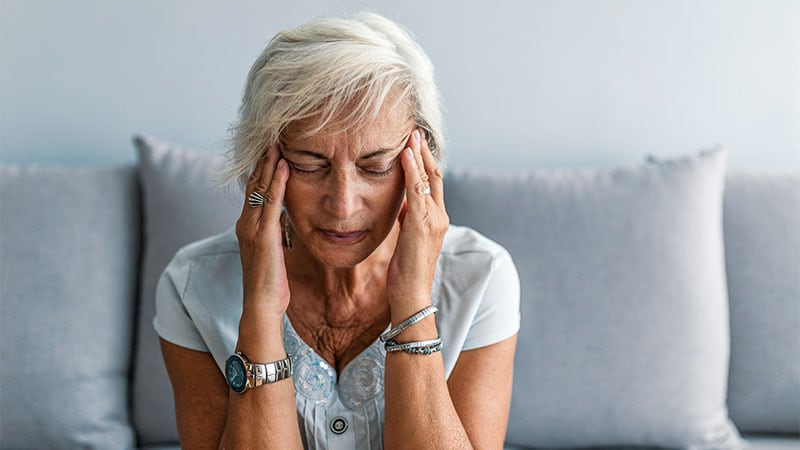MINNEAPOLIS — Roughly half of the patients experience headaches following a hemorrhagic stroke, with more than one third reporting severe pain — yet headache management remains a largely neglected aspect of post-stroke care.
“What we found is that headaches are far more common after hemorrhagic stroke than people might think. For many, the headache lingers even for months-years.” study investigator Bradley Ong, MD, a neurology resident at the Cleveland Clinic in Cleveland, told Medscape Medical News.
Patients often mention headaches while recovering from hemorrhagic stroke, but post-stroke headache tends to not be a focus of care, Ong added.
The findings were presented at American Headache Society (AHS) Annual Meeting 2025.
Knowledge Gap
“So much of stroke research focuses on the acute event, like how to stop the bleeding, and reduce disability, but I kept thinking about what happens after,” said Ong.
Ong added that when he looked into the literature he was “struck by how little we know about post-stroke headaches — particularly following hemorrhagic stroke.” This aspect of the patient experience has been largely overlooked, with surprisingly little research available on post-stroke headaches, particularly following hemorrhagic stroke.
The researchers conducted a systematic review and meta-analysis, identifying 24 studies published through December 2024. The databases included MEDLINE (1964-2024), Embase (1947-2024), and Central (1996-2024).
In all there were data on 4671 individuals who experienced a hemorrhagic stroke and were assessed for acute and chronic post-stroke headache. The majority patients were women (58.2%) living in Europe (70.8%) with a mean age of 56.9 years.
Results showed 47% (95% CI, 39%-87%) developed a headache after a hemorrhagic stroke, with 56% of patients (95% CI, 42%-97%) developing an acute or subacute headache within 30 days post-stroke, and 39% of patients (95% CI, 30%-48%) developing a chronic headache more than 3 months post-stroke. Patients developed severe headache in over one third of cases (36.9%; 95% CI, 14.4%-67.0%), which was defined as a Numeric Rating Scale score ≥ 8.
Among patients who developed post-stroke headache, 48% experienced it following a subarachnoid hemorrhage (SAH), whereas 38% developed it after an intracerebral hemorrhage (ICH).
In both cases, post-stroke headache often progressed to a chronic, persistent condition, with nearly 38% continuing into the chronic phase, the researchers reported.
“In aneurysmal SAH, most headaches had a migrainous phenotype; in contrast, most headaches in ICH had tension-type features, which ranged from moderate to severe in intensity,” the researchers noted.
Little Clinical Guidance
The likelihood of developing a post-stroke headache after a hemorrhagic stroke was influenced by several factors. Male sex was associated with lower odds of headache (pooled odds ratio [OR], 0.82; 95% CI, 0.68-0.99), while a prior history of headache significantly increased the risk (pooled OR, 4.83; 95% CI, 2.10-11.10).
Although the researchers observed considerable heterogeneity among the studies reviewed, the meta-regression analysis showed no statistically significant differences related to the risk of bias, region, population source, or human development index.
Headache does not get the same level of urgency in neurology as other symptoms such as weakness, speech problems, or seizures. “But for patients, these headaches are very real and can be debilitating. We just haven’t done enough to listen to that part of their recovery,” said Ong.
More prospective studies are necessary to improve the understanding of headaches, which frequently receive insufficient attention in research. Ong emphasized that treating headaches in stroke patients is challenging because common over-the-counter medications like nonsteroidal anti-inflammatory drugs are often unsuitable for those who have suffered a brain bleed.
“Long-term follow-up data would also be incredibly valuable, especially since a lot of these patients continue to struggle with headaches well after discharge,” said Ong.
Clinicians should be more intentional in including headache treatment as a part of stroke rehabilitation, he added.
“Right now, there’s very little guidance on how to even define post-stroke headache, and that makes it harder to study and treat. Most of the existing research also comes from a few regions in the world, so we’re missing a truly global picture. We need better, more consistent data from diverse populations to really understand how common this is and what treatments might help,” he added.
More Data Needed
Commenting on the research, Robert G. Kaniecki, MD, founder and director of the UPMC Headache Center in Pittsburgh, noted that the study’s size and scope were strengths. He added that the data are valuable because they specifically focus on patients who have experienced hemorrhagic stroke and subsequently develop headaches.
“Most prior papers have addressed headaches following stroke of any kind — hemorrhagic or the more common ischemic nonhemorrhagic stroke cases,” Kaniecki told Medscape Medical News.
The finding that acute or subacute headache affected 56% of patients was surprising — Kaniecki said he had anticipated a higher rate — while the 39% prevalence of chronic headache was also unexpected, as he had predicted it would be lower.
One limitation in the research was that the studies were mostly published before the third edition of the International Classification of Headache Disorders (ICHD-3) were developed and post-stroke headache was defined with specific criteria, Kaniecki said.
More data on patients with preexisting headaches are also needed, Kaniecki said, and he is interested in knowing how many patients in the study with post-stroke depression ended up developing headaches. “Post-stroke depression is common, and headache a frequent symptom reported by patients with depression,” Kaniecki said.
Ong reported no relevant financial relationships. Kaniecki reported no relevant financial relationships.
